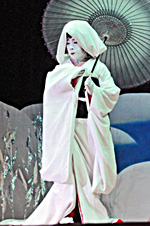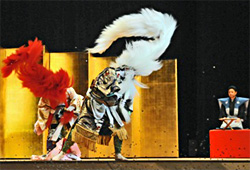The Japan Foundation, Los Angeles:Kabuki Lecture and Demonstration
The Japan Foundation, Los Angeles
 In October of 2009, the Japan Foundation, Los Angeles, presented the Kabuki Lecture and Demonstration during a five city tour in the western half of the United States. These cities included Los Angeles, San Francisco, Seattle, Portland and Denver. The word "歌舞伎 (Kabuki)" similar to the word sushi has been anglicized to kabuki and the word permeated throughout the English language. However, for your average American, kabuki is known as something that you can not understand unless you pay large sums of money for the ticket. This project was meant to explain the background of kabuki and its style in an easy to understand way through explanations and an actual scene from a famous scene so that many Amercans can grasp the true essence of the art of kabuki.
In October of 2009, the Japan Foundation, Los Angeles, presented the Kabuki Lecture and Demonstration during a five city tour in the western half of the United States. These cities included Los Angeles, San Francisco, Seattle, Portland and Denver. The word "歌舞伎 (Kabuki)" similar to the word sushi has been anglicized to kabuki and the word permeated throughout the English language. However, for your average American, kabuki is known as something that you can not understand unless you pay large sums of money for the ticket. This project was meant to explain the background of kabuki and its style in an easy to understand way through explanations and an actual scene from a famous scene so that many Amercans can grasp the true essence of the art of kabuki.
 Through the cooperation of the Shochiku Production, Kyouzou Nakamura, Matanosuke Nakamura, along with 7 other performers and 5 staff members totaling 14 members were able to travel to the United States for this project. During the performance, the actors provided explanations of the music and special characteristics of kabuki, mainly onnagata where a male plays a female role in addition to history and culture. There was also a demonstration of how the makeup is applied and how the actors are dressed for their roles. This was not just a general lecture and demonstration but a live musical performance feature four performers playing shamisen while providing vocals and three other performers playing Japanese drums and other instruments. It was a rare opportunity to get a taste of the real thing and at the same time experience what the actors go through backstage. Performances included Heron Maiden and Lion Dance, which were very fascinating.
Through the cooperation of the Shochiku Production, Kyouzou Nakamura, Matanosuke Nakamura, along with 7 other performers and 5 staff members totaling 14 members were able to travel to the United States for this project. During the performance, the actors provided explanations of the music and special characteristics of kabuki, mainly onnagata where a male plays a female role in addition to history and culture. There was also a demonstration of how the makeup is applied and how the actors are dressed for their roles. This was not just a general lecture and demonstration but a live musical performance feature four performers playing shamisen while providing vocals and three other performers playing Japanese drums and other instruments. It was a rare opportunity to get a taste of the real thing and at the same time experience what the actors go through backstage. Performances included Heron Maiden and Lion Dance, which were very fascinating.
The Los Angeles performance was conducted in conjunction with the 100th anniversary of The Japan-America Society of Southern California and included two performances, one in the afternoon and one at night. The remaining four cities each had one performance, which filled to capacity during each event. Total, there were over 4,000 attendees during the entire course of this project, which made it a great success.
Related Articles
Back Issues
- 2024.3. 4 Movie Theaters aroun…
- 2023.4.10 The 49th Japan Found…
- 2023.3.28 JF's Initiatives for…
- 2023.1.27 Living Together with…
- 2022.11.16 Inner Diversity <…
- 2022.6.21 The 48th Japan Found…
- 2022.3.22 JF's Initiatives for…
- 2022.3.14 JF's Initiatives for…
- 2022.2.14 JF's Initiatives for…
- 2022.2. 4 JF's Initiatives for…

